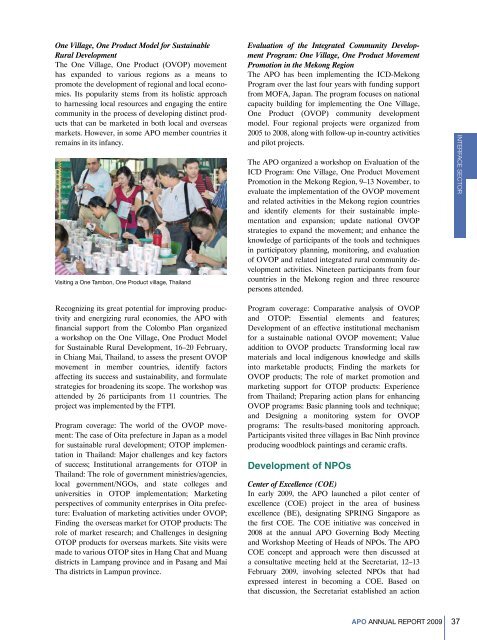Annual Report 2009 - Asian Productivity Organization
Annual Report 2009 - Asian Productivity Organization
Annual Report 2009 - Asian Productivity Organization
You also want an ePaper? Increase the reach of your titles
YUMPU automatically turns print PDFs into web optimized ePapers that Google loves.
One Village, One Product Model for Sustainable<br />
Rural Development<br />
The One Village, One Product (OVOP) movement<br />
has expanded to various regions as a means to<br />
promote the development of regional and local economies.<br />
Its popularity stems from its holistic approach<br />
to harnessing local resources and engaging the entire<br />
community in the process of developing distinct products<br />
that can be marketed in both local and overseas<br />
markets. However, in some APO member countries it<br />
remains in its infancy.<br />
Visiting a One Tambon, One Product village, Thailand<br />
Recognizing its great potential for improving productivity<br />
and energizing rural economies, the APO with<br />
financial support from the Colombo Plan organized<br />
a workshop on the One Village, One Product Model<br />
for Sustainable Rural Development, 16–20 February,<br />
in Chiang Mai, Thailand, to assess the present OVOP<br />
movement in member countries, identify factors<br />
affecting its success and sustainability, and formulate<br />
strategies for broadening its scope. The workshop was<br />
attended by 26 participants from 11 countries. The<br />
project was implemented by the FTPI.<br />
Program coverage: The world of the OVOP movement:<br />
The case of Oita prefecture in Japan as a model<br />
for sustainable rural development; OTOP implementation<br />
in Thailand: Major challenges and key factors<br />
of success; Institutional arrangements for OTOP in<br />
Thailand: The role of government ministries/agencies,<br />
local government/NGOs, and state colleges and<br />
universities in OTOP implementation; Marketing<br />
perspectives of community enterprises in Oita prefecture:<br />
Evaluation of marketing activities under OVOP;<br />
Finding the overseas market for OTOP products: The<br />
role of market research; and Challenges in designing<br />
OTOP products for overseas markets. Site visits were<br />
made to various OTOP sites in Hang Chat and Muang<br />
districts in Lampang province and in Pasang and Mai<br />
Tha districts in Lampun province.<br />
Evaluation of the Integrated Community Development<br />
Program: One Village, One Product Movement<br />
Promotion in the Mekong Region<br />
The APO has been implementing the ICD-Mekong<br />
Program over the last four years with funding support<br />
from MOFA, Japan. The program focuses on national<br />
capacity building for implementing the One Village,<br />
One Product (OVOP) community development<br />
model. Four regional projects were organized from<br />
2005 to 2008, along with follow-up in-country activities<br />
and pilot projects.<br />
The APO organized a workshop on Evaluation of the<br />
ICD Program: One Village, One Product Movement<br />
Promotion in the Mekong Region, 9–13 November, to<br />
evaluate the implementation of the OVOP movement<br />
and related activities in the Mekong region countries<br />
and identify elements for their sustainable implementation<br />
and expansion; update national OVOP<br />
strategies to expand the movement; and enhance the<br />
knowledge of participants of the tools and techniques<br />
in participatory planning, monitoring, and evaluation<br />
of OVOP and related integrated rural community development<br />
activities. Nineteen participants from four<br />
countries in the Mekong region and three resource<br />
persons attended.<br />
Program coverage: Comparative analysis of OVOP<br />
and OTOP: Essential elements and features;<br />
Development of an effective institutional mechanism<br />
for a sustainable national OVOP movement; Value<br />
addition to OVOP products: Transforming local raw<br />
materials and local indigenous knowledge and skills<br />
into marketable products; Finding the markets for<br />
OVOP products; The role of market promotion and<br />
marketing support for OTOP products: Experience<br />
from Thailand; Preparing action plans for enhancing<br />
OVOP programs: Basic planning tools and technique;<br />
and Designing a monitoring system for OVOP<br />
programs: The results-based monitoring approach.<br />
Participants visited three villages in Bac Ninh province<br />
producing woodblock paintings and ceramic crafts.<br />
Development of NPOs<br />
Center of Excellence (COE)<br />
In early <strong>2009</strong>, the APO launched a pilot center of<br />
excellence (COE) project in the area of business<br />
excellence (BE), designating SPRING Singapore as<br />
the first COE. The COE initiative was conceived in<br />
2008 at the annual APO Governing Body Meeting<br />
and Workshop Meeting of Heads of NPOs. The APO<br />
COE concept and approach were then discussed at<br />
a consultative meeting held at the Secretariat, 12–13<br />
February <strong>2009</strong>, involving selected NPOs that had<br />
expressed interest in becoming a COE. Based on<br />
that discussion, the Secretariat established an action<br />
APO ANNUAL REPORT <strong>2009</strong> 37<br />
INTERFACE SECTOR
















